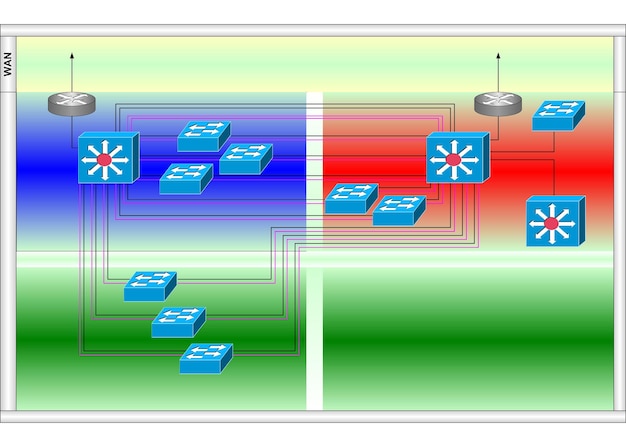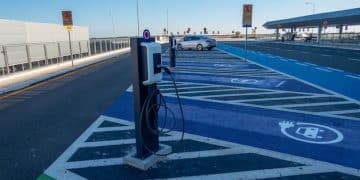Smart Grids: Powering Renewable Energy Integration for a Sustainable Future

Renewable energy integration through smart grids is crucial for maximizing the potential of solar and wind power by addressing intermittency, enhancing grid stability, and optimizing energy distribution for a sustainable energy future.
The shift towards renewable energy sources like solar and wind power is accelerating, but their intermittent nature presents a challenge to grid stability. Renewable energy integration: how smart grids can support the growth of solar and wind power, by enabling a more flexible and responsive energy infrastructure.
Understanding Renewable Energy Integration
Renewable energy sources, particularly solar and wind, are becoming increasingly vital components of the energy mix. However, their inherent variability poses significant challenges to traditional power grids. Understanding the intricacies of renewable energy integration is crucial for realizing a sustainable energy future.
The Intermittency Challenge
Solar and wind power generation depends heavily on weather conditions, leading to fluctuations in energy supply. This intermittency necessitates innovative solutions to ensure a consistent and reliable power supply.
The Role of Smart Grids
Smart grids, with their advanced sensors, communication networks, and control systems, offer a promising solution to manage the variability of renewable energy sources. By providing real-time data and enhanced control capabilities, smart grids can optimize energy distribution and maintain grid stability.
Effectively integrating renewable energy requires adapting grid infrastructure and adopting advanced technologies. This includes investing in energy storage solutions and implementing sophisticated forecasting models.
- Enhanced Grid Flexibility: Smart grids enable a more flexible energy system capable of adapting to fluctuating renewable energy inputs.
- Improved Energy Forecasting: Advanced forecasting tools allow for better prediction of renewable energy generation, improving grid management.
- Real-Time Data Management: Smart grids provide real-time data on energy production and consumption, facilitating informed decision-making.
In conclusion, understanding the challenges and opportunities of renewable energy integration is essential for creating a sustainable and resilient energy system. Smart grids play a crucial role in this transition by enabling efficient management and distribution of renewable energy sources.

Smart Grid Technologies Enabling Renewable Integration
Smart grid technologies are revolutionizing the way energy is managed and distributed. These innovations are particularly crucial for integrating renewable energy sources effectively. Let’s delve into the specific technologies that are driving this transformation.
Advanced Metering Infrastructure (AMI)
AMI systems provide real-time data on energy consumption, enabling utilities to better manage demand and optimize grid performance. This is particularly helpful in managing the fluctuating output of renewable energy sources.
Smart Sensors and Monitoring Systems
Smart sensors deployed throughout the grid provide continuous monitoring of voltage, current, and other critical parameters. This data enables proactive management of grid stability and quick response to any disruptions caused by intermittent renewable energy sources.
Integrating renewable energy requires a holistic approach that combines technological advancements with strategic planning.
- Enhanced Grid Visibility: Smart sensors and monitoring systems provide comprehensive visibility into grid operations.
- Improved Demand Response: AMI systems enable effective demand response programs, helping to balance energy supply and demand.
- Optimized Energy Distribution: Smart grid technologies facilitate optimized energy distribution, reducing transmission losses.
Smart grid technologies are pivotal in enabling the seamless integration of renewable energy. By providing real-time data, enhanced control, and improved grid flexibility, these technologies are paving the way for a sustainable energy future.
Benefits of Smart Grids for Solar and Wind Power
The integration of smart grids with solar and wind power yields a multitude of benefits, ranging from enhanced grid stability to reduced carbon emissions. Exploring these advantages underscores the importance of investing in smart grid infrastructure.
Enhanced Grid Stability
Smart grids can dynamically adjust to fluctuations in renewable energy output, maintaining grid stability and preventing blackouts. This is achieved through advanced control systems and real-time data analysis.
Reduced Carbon Emissions
By facilitating the integration of clean energy sources, smart grids contribute to a significant reduction in carbon emissions. This helps mitigate climate change and promotes a healthier environment.

The benefits of smart grids extend beyond environmental considerations, offering economic advantages and improved energy security.
- Increased Energy Efficiency: Smart grids optimize energy distribution, reducing energy waste and improving overall efficiency.
- Improved Reliability: Smart grids enhance grid reliability, minimizing the risk of power outages and ensuring a consistent energy supply.
- Economic Savings: Reduced energy waste and improved efficiency translate into significant economic savings for consumers and utilities alike.
In summary, smart grids offer a wide array of benefits that promote a sustainable and resilient energy system. By enhancing grid stability, reducing carbon emissions, and improving energy efficiency, smart grids are essential for maximizing the potential of solar and wind power.
Challenges and Solutions for Smart Grid Implementation
Despite the numerous benefits, implementing smart grids for renewable energy integration is not without its challenges. Addressing these obstacles is crucial for realizing the full potential of smart grid technology.
High Upfront Costs
The initial investment required for deploying smart grid infrastructure can be substantial. Innovative financing models and government incentives are needed to overcome this barrier.
Cybersecurity Concerns
Smart grids are vulnerable to cyber attacks, which could disrupt energy supply and compromise sensitive data. Robust cybersecurity measures are essential to protect smart grid infrastructure.
Overcoming these challenges requires a collaborative effort involving governments, utilities, and technology providers.
Regulatory Frameworks
Clear and supportive regulatory frameworks are needed to encourage investment in smart grid technologies and facilitate renewable energy integration.
- Data Privacy: Robust data privacy measures are needed to protect consumer data and maintain public trust.
- Interoperability Standards: Standardized communication protocols are essential to ensure seamless integration of different smart grid components.
- Workforce Training: Investing in workforce training is crucial to ensure that there are skilled professionals available to manage and maintain smart grid infrastructure.
Addressing the challenges of smart grid implementation requires a multifaceted approach that includes innovative financing, robust cybersecurity measures, and supportive regulatory frameworks. By overcoming these obstacles, we can unlock the full potential of smart grids for renewable energy integration.
Case Studies: Successful Smart Grid and Renewable Energy Integration
Examining successful case studies provides valuable insights into the practical application of smart grids for renewable energy integration. These examples demonstrate the tangible benefits that can be achieved through strategic investments and innovative approaches.
Germany: Smart Grids for Solar Power
Germany has made significant progress in integrating solar power into its grid using smart grid technologies. Advanced metering infrastructure (AMI) and smart sensors have enabled efficient management of solar energy fluctuations.
Denmark: Wind Power Integration
Denmark is a leader in wind power integration, leveraging smart grids to balance supply and demand. Advanced forecasting models and energy storage solutions have been instrumental in managing the variability of wind energy.
These case studies highlight the importance of tailored solutions that address the specific needs and challenges of each region.
- Texas, USA: ERCOT and Renewable Energy: The Electric Reliability Council of Texas (ERCOT) has successfully integrated a large amount of wind and solar power using advanced grid management techniques.
- California, USA: Smart Grid Initiatives: California has implemented numerous smart grid initiatives to support its aggressive renewable energy goals.
- South Australia: Battery Storage and Virtual Power Plants: South Australia has embraced battery storage and virtual power plants to enhance grid stability and integrate renewable energy effectively.
These case studies demonstrate the real-world benefits of smart grid technologies in facilitating renewable energy integration and paving the way for a sustainable energy future.
The Future of Smart Grids and Renewable Energy
The future of smart grids and renewable energy is intertwined, with ongoing innovations promising even greater efficiency and sustainability. Exploring these future trends provides a glimpse into the transformative potential of smart grid technology.
Artificial Intelligence (AI) and Machine Learning (ML)
AI and ML algorithms are being used to optimize grid operations, predict energy demand, and enhance cybersecurity. These technologies can improve the efficiency and reliability of smart grids.
Blockchain Technology
Blockchain technology offers the potential to create decentralized energy markets and improve the security and transparency of energy transactions. This could revolutionize the way energy is bought and sold.
The future of smart grids and renewable energy hinges on continued innovation and collaboration.
- Microgrids and Distributed Generation: Microgrids are becoming increasingly popular, allowing communities and businesses to generate and manage their own energy.
- Electric Vehicle (EV) Integration: Smart grids will play a crucial role in managing the charging of electric vehicles and integrating them into the energy system.
- Enhanced Energy Storage Solutions: Advancements in energy storage technologies, such as batteries and pumped hydro, will further enhance grid stability and enable greater renewable energy integration.
The convergence of smart grids and renewable energy is poised to transform the energy landscape, creating a more sustainable, efficient, and resilient energy future. By embracing innovation and fostering collaboration, we can unlock the full potential of smart grid technology.
| Key Point | Brief Description |
|---|---|
| 💡 Smart Grids | Enable efficient renewable energy integration by managing intermittency. |
| ⚡ Advanced Technologies | AMI, sensors, and forecasting enhance grid visibility and response. |
| 🌱 Environmental Benefits | Reduce carbon emissions by facilitating clean energy sources. |
| 🛡️ Cybersecurity | Protect smart grid infrastructure from cyber attacks. |
Frequently Asked Questions (FAQ)
▼
A smart grid is an advanced electricity network that uses digital technology to improve efficiency, reliability, and sustainability of energy delivery. It integrates renewable energy sources more effectively.
▼
Smart grids enhance renewable energy integration by providing real-time data, improving grid stability, and enabling better management of intermittent energy sources like solar and wind.
▼
Key technologies include advanced metering infrastructure (AMI), smart sensors, communication networks, and advanced control systems, all working to optimize energy distribution and consumption.
▼
Benefits include reduced carbon emissions, enhanced grid reliability, increased energy efficiency, and economic savings for consumers and utilities, promoting a sustainable energy system.
▼
Challenges include high upfront costs, cybersecurity concerns, and the need for supportive regulatory frameworks to encourage investment and ensure data privacy and interoperability.
Conclusion
Renewable energy integration through smart grids represents a critical pathway towards a sustainable energy future. By addressing the challenges of intermittency and enhancing grid stability, smart grids enable the seamless integration of solar and wind power, paving the way for a cleaner and more resilient energy system.





